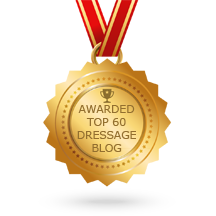|
Straightness is referred to in dressage as being a particularly important quality. When a horse is straight the energy created in the quarters lifts the forehand and makes the horse manoeuvrable, both in turns and in collection and extension. This desirable quality of straightness is not something that can be developed in isolation, it is the result of a supple and balanced horse. Balance and suppleness are linked and need to be developed together; an unbalanced horse will have to carry his weight unevenly and this affects his suppleness and a supple horse can more easily maintain his balance. A horse that is out of balance will carry weight in a shoulder, which is most clearly felt when you ride a circle. When the stiff side is to the inside of the circle, the weight falls to the inside shoulder and the circle starts to get smaller. On the other rein, where the stiff side is to the outside, the horse falls out of the circle, giving the impression that he is moving correctly round the circle, but in fact he is being held up by the side of the school or pulled round by the rider’s hands. Poorly ridden circles change nothing, the tension and stiffness in the horse are re-enforced with the weight remaining in the shoulder. Initial exercises should center on creating a supple, balance horse using movements to lengthen the muscles on the soft side and strengthen the muscles on the stiff side, and the most important of these is a circle. Correctly ridden, circles teach horses to bring the inside hind under the body and stretch and strengthen laterally. It is the beginning of a process that results in a horse well balanced across all four legs; straight. To ride a circle, bring your outside shoulder forward and brush the inside leg lightly forward at the girth. Turning with the inside rein twists the horse’s head, and bringing it back blocks the inside hind from coming forward. Keep the rein soft and let the hands follow the position of your shoulders so you have an even contact. Your horse should give round the inside leg and keep the weight balanced across both shoulders. If your horse puts weight on the inside shoulder, re-establish the inside bend and then move him back to the original circle, directing with your leg and maintaining the bend. If he puts weight in the outside shoulder, use the outside hand and/or leg aid to straighten him and bring the shoulder back under. When you change the rein, make your change of bend over several strides. Move from one bend to straight by sitting straight. Then ask for the bend in the new direction. Give yourself plenty of space so your horse learns to maintain his balance throughout. The change will become quicker as your horse becomes stronger and more balanced. © Training Riders, Transforming Horses
Comments are closed.
|
AuthorDiane Followell Classical Dressage Trainer 
|
Telephone+44 (0)7931551014
|
|
© Diane Followell 2015 -2024.
All Rights Reserved.
All images and content are copyright Diane Followell unless otherwise stated.
All Rights Reserved.
All images and content are copyright Diane Followell unless otherwise stated.

 RSS Feed
RSS Feed

